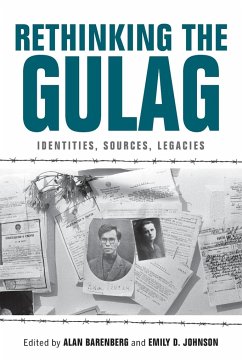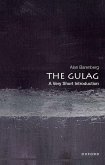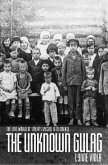- Broschiertes Buch
- Merkliste
- Auf die Merkliste
- Bewerten Bewerten
- Teilen
- Produkt teilen
- Produkterinnerung
- Produkterinnerung
Moving away from grand metaphorical or theoretical models, Rethinking the Gulag instead unearths the complexities and nuances of experience that define the new wave of Gulag studies.
Andere Kunden interessierten sich auch für
![The Soviet Gulag The Soviet Gulag]() Associate Professor Jeffrey S. Hardy (USA Brigham Young UniversityThe Soviet Gulag11,99 €
Associate Professor Jeffrey S. Hardy (USA Brigham Young UniversityThe Soviet Gulag11,99 €![Iron Curtain Iron Curtain]() Anne ApplebaumIron Curtain12,99 €
Anne ApplebaumIron Curtain12,99 €![The Gulag Doctors The Gulag Doctors]() Dan HealeyThe Gulag Doctors26,99 €
Dan HealeyThe Gulag Doctors26,99 €![The Soviet Century The Soviet Century]() Karl SchlogelThe Soviet Century22,99 €
Karl SchlogelThe Soviet Century22,99 €![The Soviet Century The Soviet Century]() Karl SchlogelThe Soviet Century32,99 €
Karl SchlogelThe Soviet Century32,99 €![The Gulag The Gulag]() Alan Barenberg (Associate Professor, Department of History, AssociaThe Gulag8,99 €
Alan Barenberg (Associate Professor, Department of History, AssociaThe Gulag8,99 €![The Unknown Gulag The Unknown Gulag]() Lynne Viola (Professor of History, Professor of History, UniversityThe Unknown Gulag23,99 €
Lynne Viola (Professor of History, Professor of History, UniversityThe Unknown Gulag23,99 €-
-
-
Moving away from grand metaphorical or theoretical models, Rethinking the Gulag instead unearths the complexities and nuances of experience that define the new wave of Gulag studies.
Produktdetails
- Produktdetails
- Verlag: Indiana University Press
- Seitenzahl: 322
- Erscheinungstermin: 1. März 2022
- Englisch
- Abmessung: 229mm x 152mm x 19mm
- Gewicht: 498g
- ISBN-13: 9780253059611
- ISBN-10: 0253059615
- Artikelnr.: 61259879
- Herstellerkennzeichnung
- Libri GmbH
- Europaallee 1
- 36244 Bad Hersfeld
- gpsr@libri.de
- Verlag: Indiana University Press
- Seitenzahl: 322
- Erscheinungstermin: 1. März 2022
- Englisch
- Abmessung: 229mm x 152mm x 19mm
- Gewicht: 498g
- ISBN-13: 9780253059611
- ISBN-10: 0253059615
- Artikelnr.: 61259879
- Herstellerkennzeichnung
- Libri GmbH
- Europaallee 1
- 36244 Bad Hersfeld
- gpsr@libri.de
Alan Barenberg is the Buena Vista Foundation Associate Professor of History at Texas Tech University. He is author of Gulag Town, Company Town: Forced Labor and Its Legacy in Vorkuta. Emily D. Johnson is the Brian and Sandra O'Brien Presidential Professor of Russian at the University of Oklahoma. She is author of How St. Petersburg Learned to Study Itself: The Russian Idea of Kraevedenie and editor and translator of Gulag Letters by Arsenii Formakov.
1. Introduction: Gulag Studies since the Archival Revolution, by Alan
Barenberg and Emily D. Johnson
Part I: Identities
2. Religious Identity, Practice, and Hierarchy at the Solovetskii Camp of
Forced Labor of Special Significance, by Jeffrey S. Hardy
3. Censoring the Mail in Stalin's Multi-ethnic Penal System: The Use of
Languages Other Than Russian in Soviet Inmate Correspondence, by Emily D.
Johnson
4. "Who are you in life?": The Gulag Reputation System and its Legacies
Today, by Gavin Slade
5. The Real Gulag: Commentary on the "Identities" Section, by Lynne Viola
Part II: Sources
6. "They won't survive for long": Soviet Officials on Medical Release
Procedures, by Mikhail Nakonechnyi
7. Applying Digital Methods to Forced Labor History: German POWs During and
After the Second World War, by Susan Grunewald
8. Framing Gulag Memoirs: A Distant Reading, by Sarah J. Young
9. Researching the Gulag in the Era of "Big Data": Commentary on the
"Sources" Section, by Judith Pallot
Part III: Legacies
10. The Role of Nature in Gulag Poetry: Shalamov and Zabolotsky, by
Josephine von Zitzewitz
11. "I would very much like to read your story about Kolyma": Georgii
Demidov, Varlam Shalamov, and the Development of Gulag Prose, 1965-67, by
Alan Barenberg
12. The Necropolis of the Gulag as a Historical-Cultural Object: An
Overview and Explication of the Problem, by Irina Anatolievna Flige
(translated by Josephine von Zitzewitz)
13. Sites and Sounds of the Camps: Commentary on the "Legacies" Section, by
Alexander Etkind
14. Afterword, by Alan Barenberg and Emily D. Johnson
Index
Barenberg and Emily D. Johnson
Part I: Identities
2. Religious Identity, Practice, and Hierarchy at the Solovetskii Camp of
Forced Labor of Special Significance, by Jeffrey S. Hardy
3. Censoring the Mail in Stalin's Multi-ethnic Penal System: The Use of
Languages Other Than Russian in Soviet Inmate Correspondence, by Emily D.
Johnson
4. "Who are you in life?": The Gulag Reputation System and its Legacies
Today, by Gavin Slade
5. The Real Gulag: Commentary on the "Identities" Section, by Lynne Viola
Part II: Sources
6. "They won't survive for long": Soviet Officials on Medical Release
Procedures, by Mikhail Nakonechnyi
7. Applying Digital Methods to Forced Labor History: German POWs During and
After the Second World War, by Susan Grunewald
8. Framing Gulag Memoirs: A Distant Reading, by Sarah J. Young
9. Researching the Gulag in the Era of "Big Data": Commentary on the
"Sources" Section, by Judith Pallot
Part III: Legacies
10. The Role of Nature in Gulag Poetry: Shalamov and Zabolotsky, by
Josephine von Zitzewitz
11. "I would very much like to read your story about Kolyma": Georgii
Demidov, Varlam Shalamov, and the Development of Gulag Prose, 1965-67, by
Alan Barenberg
12. The Necropolis of the Gulag as a Historical-Cultural Object: An
Overview and Explication of the Problem, by Irina Anatolievna Flige
(translated by Josephine von Zitzewitz)
13. Sites and Sounds of the Camps: Commentary on the "Legacies" Section, by
Alexander Etkind
14. Afterword, by Alan Barenberg and Emily D. Johnson
Index
1. Introduction: Gulag Studies since the Archival Revolution, by Alan
Barenberg and Emily D. Johnson
Part I: Identities
2. Religious Identity, Practice, and Hierarchy at the Solovetskii Camp of
Forced Labor of Special Significance, by Jeffrey S. Hardy
3. Censoring the Mail in Stalin's Multi-ethnic Penal System: The Use of
Languages Other Than Russian in Soviet Inmate Correspondence, by Emily D.
Johnson
4. "Who are you in life?": The Gulag Reputation System and its Legacies
Today, by Gavin Slade
5. The Real Gulag: Commentary on the "Identities" Section, by Lynne Viola
Part II: Sources
6. "They won't survive for long": Soviet Officials on Medical Release
Procedures, by Mikhail Nakonechnyi
7. Applying Digital Methods to Forced Labor History: German POWs During and
After the Second World War, by Susan Grunewald
8. Framing Gulag Memoirs: A Distant Reading, by Sarah J. Young
9. Researching the Gulag in the Era of "Big Data": Commentary on the
"Sources" Section, by Judith Pallot
Part III: Legacies
10. The Role of Nature in Gulag Poetry: Shalamov and Zabolotsky, by
Josephine von Zitzewitz
11. "I would very much like to read your story about Kolyma": Georgii
Demidov, Varlam Shalamov, and the Development of Gulag Prose, 1965-67, by
Alan Barenberg
12. The Necropolis of the Gulag as a Historical-Cultural Object: An
Overview and Explication of the Problem, by Irina Anatolievna Flige
(translated by Josephine von Zitzewitz)
13. Sites and Sounds of the Camps: Commentary on the "Legacies" Section, by
Alexander Etkind
14. Afterword, by Alan Barenberg and Emily D. Johnson
Index
Barenberg and Emily D. Johnson
Part I: Identities
2. Religious Identity, Practice, and Hierarchy at the Solovetskii Camp of
Forced Labor of Special Significance, by Jeffrey S. Hardy
3. Censoring the Mail in Stalin's Multi-ethnic Penal System: The Use of
Languages Other Than Russian in Soviet Inmate Correspondence, by Emily D.
Johnson
4. "Who are you in life?": The Gulag Reputation System and its Legacies
Today, by Gavin Slade
5. The Real Gulag: Commentary on the "Identities" Section, by Lynne Viola
Part II: Sources
6. "They won't survive for long": Soviet Officials on Medical Release
Procedures, by Mikhail Nakonechnyi
7. Applying Digital Methods to Forced Labor History: German POWs During and
After the Second World War, by Susan Grunewald
8. Framing Gulag Memoirs: A Distant Reading, by Sarah J. Young
9. Researching the Gulag in the Era of "Big Data": Commentary on the
"Sources" Section, by Judith Pallot
Part III: Legacies
10. The Role of Nature in Gulag Poetry: Shalamov and Zabolotsky, by
Josephine von Zitzewitz
11. "I would very much like to read your story about Kolyma": Georgii
Demidov, Varlam Shalamov, and the Development of Gulag Prose, 1965-67, by
Alan Barenberg
12. The Necropolis of the Gulag as a Historical-Cultural Object: An
Overview and Explication of the Problem, by Irina Anatolievna Flige
(translated by Josephine von Zitzewitz)
13. Sites and Sounds of the Camps: Commentary on the "Legacies" Section, by
Alexander Etkind
14. Afterword, by Alan Barenberg and Emily D. Johnson
Index








